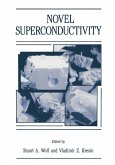

Alle Infos zum eBook verschenken

- Format: PDF
- Merkliste
- Auf die Merkliste
- Bewerten Bewerten
- Teilen
- Produkt teilen
- Produkterinnerung
- Produkterinnerung

Hier können Sie sich einloggen

Bitte loggen Sie sich zunächst in Ihr Kundenkonto ein oder registrieren Sie sich bei bücher.de, um das eBook-Abo tolino select nutzen zu können.
Self-Trapped Excitons discusses the structure and evolution of the self-trapped exciton (STE) in a wide range of materials. It includes a comprehensive review of experiments and extensive tables of data. Emphasis is given throughout to the unity of the basic physics underlying various manifestations of self-trapping, with the theory being developed from a localized, atomistic perspective. The topics treated in detail in relation to STE relaxation include spontaneous symmetry breaking, lattice defect formation, radiation damage, and electronic sputtering.
- Geräte: PC
- ohne Kopierschutz
- eBook Hilfe
- Größe: 38.74MB
![Superlattices and Other Heterostructures (eBook, PDF) Superlattices and Other Heterostructures (eBook, PDF)]() Eougenious L. IvchenkoSuperlattices and Other Heterostructures (eBook, PDF)73,95 €
Eougenious L. IvchenkoSuperlattices and Other Heterostructures (eBook, PDF)73,95 €![Semiconductor Quantum Dots (eBook, PDF) Semiconductor Quantum Dots (eBook, PDF)]() Semiconductor Quantum Dots (eBook, PDF)233,95 €
Semiconductor Quantum Dots (eBook, PDF)233,95 €![Ultrafast Phenomena in Semiconductors (eBook, PDF) Ultrafast Phenomena in Semiconductors (eBook, PDF)]() Ultrafast Phenomena in Semiconductors (eBook, PDF)113,95 €
Ultrafast Phenomena in Semiconductors (eBook, PDF)113,95 €![Nanocrystalline Ceramics (eBook, PDF) Nanocrystalline Ceramics (eBook, PDF)]() Markus WintererNanocrystalline Ceramics (eBook, PDF)73,95 €
Markus WintererNanocrystalline Ceramics (eBook, PDF)73,95 €![Electronic States and Optical Transitions in Semiconductor Heterostructures (eBook, PDF) Electronic States and Optical Transitions in Semiconductor Heterostructures (eBook, PDF)]() Fedor T. VaskoElectronic States and Optical Transitions in Semiconductor Heterostructures (eBook, PDF)40,95 €
Fedor T. VaskoElectronic States and Optical Transitions in Semiconductor Heterostructures (eBook, PDF)40,95 €![Electrets (eBook, PDF) Electrets (eBook, PDF)]() Electrets (eBook, PDF)40,95 €
Electrets (eBook, PDF)40,95 €![Novel Superconductivity (eBook, PDF) Novel Superconductivity (eBook, PDF)]() Stuart A. WolfNovel Superconductivity (eBook, PDF)73,95 €
Stuart A. WolfNovel Superconductivity (eBook, PDF)73,95 €-
-
-
Dieser Download kann aus rechtlichen Gründen nur mit Rechnungsadresse in A, B, BG, CY, CZ, D, DK, EW, E, FIN, F, GR, HR, H, IRL, I, LT, L, LR, M, NL, PL, P, R, S, SLO, SK ausgeliefert werden.
- Produktdetails
- Verlag: Springer Berlin Heidelberg
- Seitenzahl: 410
- Erscheinungstermin: 8. März 2013
- Englisch
- ISBN-13: 9783642852367
- Artikelnr.: 53237045
- Verlag: Springer Berlin Heidelberg
- Seitenzahl: 410
- Erscheinungstermin: 8. März 2013
- Englisch
- ISBN-13: 9783642852367
- Artikelnr.: 53237045







